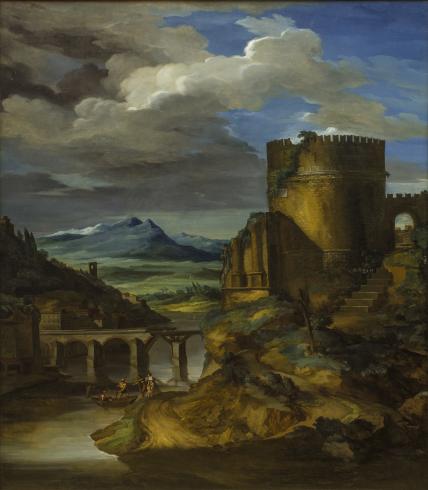Shortly after failing to win the Prix de Rome, Géricault set off for Italy in October 1816. No sooner had he arrived in Rome than he visited the Sistine Chapel to admire Michelangelo’s frescos. But it was in the streets in particular that the young painter found his inspiration.
The young Géricault was critical of the routine of the Rome School and kept his distance from the French artistic community. He returned to Paris in the autumn of 1817 and began work on his monumental painting, The Raft of the Medusa (1819, Paris, Louvre Museum).
Landscape with a tomb, whose genesis and intended destination remain a mystery, was undoubtedly painted with two other large landscapes in 1818 when Géricault returned to France. The vast vista punctuated with architectural elements conforms with the rules of landscape painting inherited from Poussin. However, it gives off an air of anxiety and strangeness signifying a new sensitivity that heralded Romanticism.
The mountains visible in the distance conjure up the barrier of the Alps which travellers must cross to reach Italy. The cloudy sky adds a dramatic touch to the craggy site dominated by ruined architecture and the building perched on a rocky spur harks back to the ancient circular tomb of Cecilia Metella. The small boat towards which the frightened couple are moving recalls Charon’s boat, which received the souls of the dead in mythology and carried them over the river Acheron. At the centre of the composition are stocks on which human limbs are displayed, referring with morbid realism to the torture inflicted on bandits who demanded ransom money on the roads of southern Italy.
Tackling a landscape on this one occasion, Géricault was already demonstrating the profound originality of his art, which was much admired by the Romantic generation.
I. C.

City of Paris municipal collection's website
The collections portal can be used to search the collections of Paris’s 14 municipal museums (approximately 336,000 works, including 43,000 belonging to the Petit Palais).
It is also possible to download around 12,000 images of the museum’s works free of charge.
Access the Museums of the City of Paris collections portal
Extern databases
Discover a selection of databases online presenting works from the Petit Palais or documents concerning the history of the museum.

